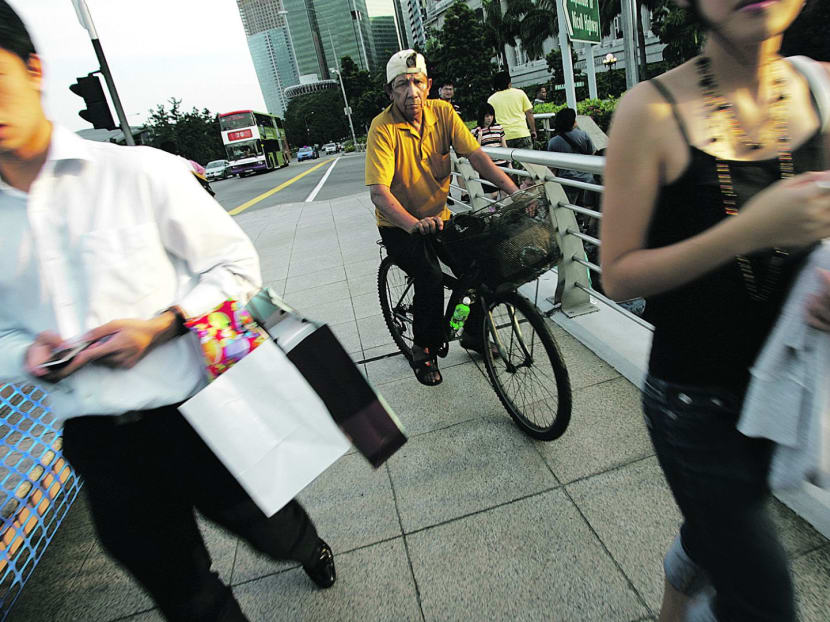Allow bicycles and e-scooters on footpaths, says panel, but within limits
SINGAPORE — Recommending a change in the rules to allow bicycles on footpaths, a panel looking into the proposed rules and code of conduct for non-motorist road users has set in place safeguards against potential conflicts, by way of speed limits.
SINGAPORE — Recommending a change in the rules to allow bicycles on footpaths, a panel looking into the proposed rules and code of conduct for non-motorist road users has set in place safeguards against potential conflicts, by way of speed limits.
The recommendations from the Active Mobility Advisory Panel— comprising 14 representatives from various groups such as seniors, youths, grassroots, cyclists and motorists — come after calls for clearer rules on cycling and other personal transport tools that have grown in popularity recently.
The panel submitted its recommendations, arrived at after eight months of work, to the Ministry of Transport on Thursday (March 17). The ministry said in a separate statement that it will study the suggestions and give its response in due course.
The panel suggested a 15kmh speed limit for footpaths, which can be used by bicycles and personal mobility aids and devices, such as electric scooters, kick-scooters, and hoverboards. However, pavements should continue to be off-limits to electric bicycles, it said. Cyclists are hitherto prohibited from using footpaths, except in Tampines town.
Shared/cycling paths, on the other hand, should not exempt any of such personal transport tools although speeds must be capped at 25kmh, the panel recommended.
To minimise danger to vulnerable road users, there should be restrictions placed on the physical criteria for these transport tools, including a 20kg weight limit, and a 700mm width cap to give enough crossing space on pavements.
Apart from these rules, the panel’s work also involved recommendations for a code of conduct for the use of the different paths, as well as ways to pick out errant road users.
For instance, all personal transport tools should have white lights clipped on at the front and red lights at the back. These have to be switched on when it turns dark.
Cycling maximum two abreast is allowed on the roads with at least two lanes in that direction. This is forbidden for roads with bus lanes in operation.
Those on personal mobility devices should give way to pedestrians and stop and look out for oncoming traffic when approaching areas with high pedestrian traffic, such as bus stops. When there are accidents, they should stop to render assistance and exchange particulars.
Associate Professor Muhammad Faishal Ibrahim, who was the Parliamentary Secretary for Transport when he took on the post of chair for the panel, said at a briefing on Thursday that education is key to ensuring the proposed rules and guidelines work.
“The panel focused on developing a set of rules and a code of conduct which we believe are practical, clear, fair and, most importantly, safeguards the safety of all users,” he said. “We want to make sure it’s something people are aware of ... so this will take some time, you need to go out there and outreach to the people and we hope over time ... this set of rules and norms will become second nature.”
To help keep road users in check, the authorities could use innovative street furniture, which technology such as CCTVs could be used to single out unsafe behaviour.
Dr Faishal said that close enforcement is needed, if people are to feel confident of the rules and code of conduct.
The Land Transport Authority’s (LTA) chief executive Chew Men Leong — who sits on the panel — said the LTA may take a “centralised role” in enforcement, if the government accepts the recommendations.
Explaining its decision to allow bicycles on footpaths, the panel said feedback from its public consultation exercise showed most respondents to be amenable to sharing the space, as long as there are rules or guidelines in place. As electric bicycles are commonly used by the elderly, allowing LTA-approved electric bicycles on cycling/shared paths would give vulnerable users a safer option than requiring them to keep to the road.
Nevertheless, there were strong views concerning the prevalence of dangers posed by illegally-modified electric bicycles. In response, the panel recommended that the Government consider introducing a registration system to facilitate enforcement.







